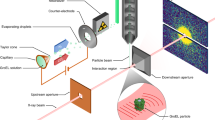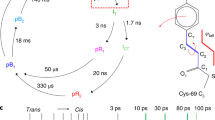Abstract
TECHNIQUES for measuring rates of crystallization have been the subject of recent reviews1,2. Most of the methods described are not applicable to fast rates. A microscope-ciné camera technique3 can be used when the species crystallizes in visibly discernible forms; but interpretation of results is sometimes complicated by impingement of boundaries between the crystalline entities. A method independent of the texture of the crystallizing species but requiring birefringence in the crystallized specimen has been developed in these laboratories. This consists, essentially, of following the increase in depolarization of plane-polarized light by the crystallizing specimen. Birefringence and crystallinity do not occur concurrently under all conditions of crystallization4, but it is believed that when crystallization takes place from a melt under no external stress, measurement of rate of depolarization of light by the crystallizing sample parallels the development of crystallinity.
This is a preview of subscription content, access via your institution
Access options
Subscribe to this journal
Receive 51 print issues and online access
$199.00 per year
only $3.90 per issue
Buy this article
- Purchase on Springer Link
- Instant access to full article PDF
Prices may be subject to local taxes which are calculated during checkout
Similar content being viewed by others
References
Mandelkern, L., in “Growth and Perfection of Crystals”, edit. by Doremus, R. H., Roberts, B. W., and Turnbull, D., 467 (Wiley, New York, 1958).
Mandelkern, L., Soc. Plastics Eng. J., 15, No. 1 (1959); Rubber Chem. and Tech., 32, 1392 (1959).
Burnett, B. B., and McDevit, W. F., J. App. Phys., 28, 1101 (1957).
Bunn, C. W., “Fibres from Synthetic Polymers”, Chap. 10 (R. Hill, Elsevier, 1953).
Avrami, M., J. Chem. Phys., 7, 1103 (1939); 8, 212 (1940); 9, 177 (1941).
McLaren, J. V. (unpublished work).
Flory, P. J., and McIntyre, A. D., J. Polymer Sci., 90, 592 (1955).
McIntyre, A. D., Ph.D. thesis, Cornell University (1956). Univ. Microfilm No. 16256.
Mandelkern, L., Quinn, F. A., and Flory, P. J., J. App. Phys., 25, 830 (1954).
Author information
Authors and Affiliations
Rights and permissions
About this article
Cite this article
MAGILL, J. A New Technique for following Rapid Rates of Crystallization. Nature 187, 770–771 (1960). https://doi.org/10.1038/187770a0
Issue Date:
DOI: https://doi.org/10.1038/187770a0
This article is cited by
-
Conditions of nucleation in crystallizable polymers: reconnaissance of positions — a critical evaluation
Colloid & Polymer Science (1997)
-
Applicability of light transmission technique to studies of crystalline polymers texture
Kolloid-Zeitschrift & Zeitschrift für Polymere (1967)
-
Crystallization of Isotactic Polypropylene using a Light Depolarization Technique
Nature (1961)
Comments
By submitting a comment you agree to abide by our Terms and Community Guidelines. If you find something abusive or that does not comply with our terms or guidelines please flag it as inappropriate.



